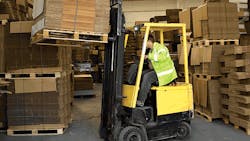Powered industrial trucks, more commonly known as forklifts, are the worker bees in many manufacturing and warehousing operations. Although primarily used to move materials, they also can be used to raise, lower or remove large objects or a number of smaller objects on pallets or in boxes, crates or other containers. In other words, they do the heavy lifting for us.
Powered industrial trucks can either be ridden by the operator or controlled by a walking operator, and there are many types of powered industrial trucks. Each type presents different operating hazards. For example, a sit-down, counterbalanced high-lift rider truck is more likely than a motorized hand truck to be involved in a falling load accident because the sit-down rider truck can lift a load much higher than a hand truck.
Workplace type and conditions also are factors in hazards commonly associated with powered industrial trucks. For example, retail establishments often face greater challenges than other worksites in maintaining pedestrian safety. Beyond that, many workers are injured when: lift trucks are inadvertently driven off loading docks; lifts fall between docks and an unsecured trailer; they are struck by a lift truck; or they fall while on elevated pallets and tines.
Match the Specs to the Facility, Tasks
Keep in mind that there are no typical specs, just as there is no typical customer. The specifications of a particular forklift have to match the particular facility where it's going to be used and the tasks for which it will be used.
This especially is important for companies with many facilities or large facilities that require a large number of forklifts, as they often have a number of different tasks for which forklifts are needed and each area of a large facility will offer different structural features. The width of aisles can impact forklift safety and specifications; and aisles can be narrow, which will dictate the overall size of the equipment. Whether the power lift truck is used indoors or outdoors will dictate the fuel source (electric – battery – and internal combustion) and could impact safety.
When used indoors, you will need to consider aisle width, weight, maximum lift height and overhead obstructions. When used outdoors, you will need to consider the type of tire. Some applications may require speed lifting, whereas this is less important for other operations.
Lighting can be another specification to consider. Is the facility dark? Do you require the forklift to have a lighting source either to make the facility more visible for the driver or the forklift more visible for pedestrians working around it?
Questions to Ask
When speaking with powered industrial truck dealers, some key points you should cover include: the type, weight, dimensions and packaging of the material to be lifted; the height to which the material will be lifted; whether the operating environment is indoors, outdoors or both; the condition of the operating surfaces; and the projected hours of use on a daily, weekly and monthly basis. Any special needs or customized equipment also should be taken into account in the recommendation of a forklift.
OSHA Regulations
It is a violation of federal law for anyone under 18 years of age to operate a forklift or for anyone over 18 years of age who is not properly trained and certified to do so. OSHA notes that determining the best way to protect workers from injury "largely depends on the type of truck operated and the worksite where it is being used."
The OSHA standard for powered industrial truck training [29 CFR 1910.178(l)] requires that an employer provide training to truck operators on a variety of topics. Among these topics are vehicle inspection and maintenance that the operator will be required to perform.
Daily, pre-shift inspection of powered industrial trucks is required by OSHA standards.
The agency offers sample checklists on its web site (https://www.osha.gov/dte/library/pit/daily_pit_checklist.html) that include tasks like checking fluid levels and tire pressure, ensuring guards are in place and making sure the accelerator, steering and brakes are in proper working order.
By following the above tips and instructions, you can rest assured that you will select the right forklift and operate it in a safe manner.
Andrew Mark is a freelance writer for Walsh Equipment, which provides truck, earth moving products and services across Melbourne, Australia.
